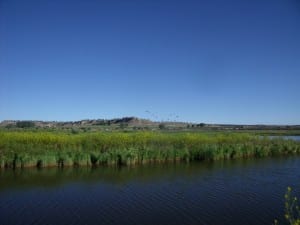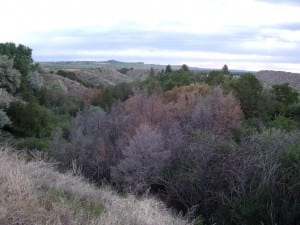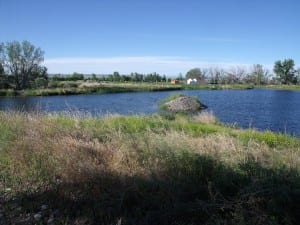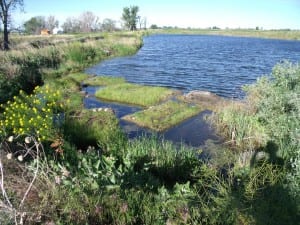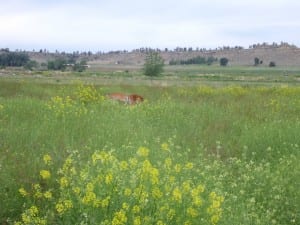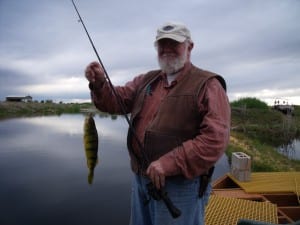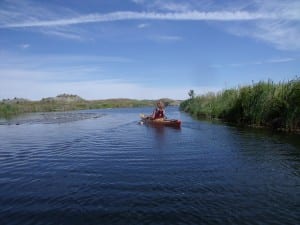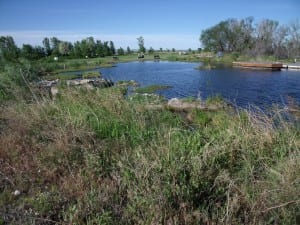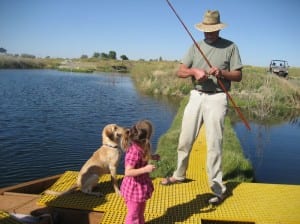|
Tag: floating islands international
Nature’s water purifiers help clean up lakes
 (Copyright: Floating Islands International)
(Copyright: Floating Islands International)More and more of our waterways are being starved of life through pollution. One simple, yet improbable, solution? Cover rafts in plants.
The solution was as simple as it was improbable: cover rafts with plants, and set them afloat in the lake. Within a year-and-a-half, the algal blooms were gone. Water clarity improved. Oxygen levels rose. Today, the lake is home to a thriving community of fish, including black crappie, yellow perchand Yellowstone cutthroat trout.
The story of Fish Fry Lake demonstrates the power of mimicking wetlands to clean up dirty waterways. Wetlands are sometimes called nature’s own water purifiers: as dirty water moves through a sprawling marsh, the bacteria that cling to wetland plants, timber, rocks, and other debris consume and process some common water pollutants. Other contaminants get trapped in the mud and muck. As result of these and other processes, the water that eventually flows out of a wetland is much cleaner than the stream that came trickling in. Dozens of unique habitat models at fishiding.com
By creating floating treatment wetlands out of small, human-engineered rafts of vegetation, researchers and entrepreneurs hope to provide these same ecological services to small, polluted bodies of water that may be far from a natural marsh. “BioHaven floating islands are concentrated wetland systems that are essentially biomimicking nature’s wetland effect,” says Bruce Kania, the founder and research director of Floating Island International, the company behind the Fish Fry Lake rafts.
Cleansing power
To construct a BioHaven island, the company starts with layers of mesh made from recycled plastic. They assemble this mesh into a floating raft – which can be as small as a home aquarium or nearly as large as a football field – and top it with soil and plants. They launch the island into a lake, pond, stream, or lagoon, anchoring it in place. Over time, the plants’ roots grow into and through the raft’s porous matrix, descending into the water below. At the same time, bacteria colonise the island, assembling into sticky, slimy sheets called biofilm that coat the floating matrix and the suspended plant roots.
This bacterial biofilm is the secret to a floating island’s cleansing power. Overgrowth of algae from nitrogen and phosphorus pollution can cause several problems, preventing sunlight from reaching subaquatic plants and starving a body of water of the oxygen needed to sustain fish populations and other animal life. A dead zone, like the one is Fish Fry Lake, is often the ultimate result. The biofilm bacteria consume nitrogen and phosphorous, however, and as polluted water flows through and around a floating island, the bacteria converts these contaminants into less harmful substances. Though the bacteria do the brunt of the work, the plant roots suspended from the floating island also play their part, absorbing some of the nitrogen and phosphorous through their roots.
In Fish Fry Lake, for instance, Floating Island International deployed several islands, which together covered almost 2% of the lake’s 6.5-acre (2.6-hectare) surface area. Over the course of four years, the islands helped reduce nitrogen concentrations by 95% and phosphorus concentrations by nearly 40%. Today, levels of dissolved oxygen are sixty times what they once were.
Clearer, cleaner, healthier
The system also mechanically filters out other pollutants, like metals and particulates. “The sticky biofilm essentially keeps the water clear because all the suspended solids tend to bond to it,” says Kania. Floating Island International, which has deployed more than 4,400 of their artificial wetland systems worldwide, has documented this effect in multiple case studies. For example, the concentrations of suspended solids, copper, lead, zinc, and oil and grease fell dramatically after a floating island was installed in a stormwater pond in Montana. Controlled laboratory studies and research by scientists not affiliated with the company have also foundthat floating treatment wetlands can reduce the levels of many common water pollutants.
Some scientists are now exploring how to optimise the design of floating islands – probing, for instance, which plants do the best job of removing pollutants. Gary Burtle, an aquaculture specialist at the University of Georgia, thinks we can get even more out of these artificial wetlands by seeding the rafts with plants that are of commercial value, such as lettuces and herbs. Burtle is screening a number of potential plant candidates – if he finds one that grows well on a floating island, we may soon see constructed wetland systems that “give us a little bit more return”, he says, producing saleable crops while purifying the water.
Meanwhile, the removal of contaminants not only improves the water itself, but also helps to foster a healthier ecosystem. Clearer water allows light to penetrate deeper, encouraging the growth of various aquatic plants, which produce oxygen and become part of the food chain, supporting larger populations of fish and other animals. “You end up with a waterway that can be abundant,” Kania says, “that can be verdant even at depth.” The organic debris that attaches itself to the underside of a floating island also becomes a source of food for fish and other aquatic organisms, and the island itself provides new habitat for birds.
“The concept of how to get back to a healthy waterway,” Kania says, “is very simple: nature’s wetland effect.” All we have to do is simulate it.

If you would like to comment on this article or anything else you have seen on Future, head over to our Facebook page or message us onTwitter.
Eat more fish to clean your lake?
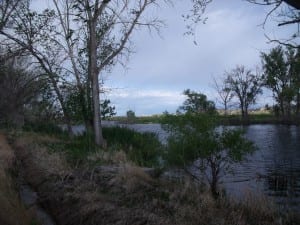 A few weeks ago, my wife Renee’ and I took a trip to Shepherd Montana, headquarters of Floating Island International Inc. We had been invited to stay on the ranch and to see for ourselves how Bruce Kania and his wife Anne, are growing huge fish fast with a woven matrix of inert substrates called BioHaven, or Floating Treatment Wetlands. I had been in contact with Bruce for some time, learning about how excessive nutrients brought in from runoff can be turned into fresh, tasty fish. Not only do the Kania’s grow fish, but frogs, minnows, pheasant, deer and all species of waterfowl prosper in their efforts. Even Yellowstone cutthroat trout flourish in this superior environment, along with crappie and perch and various minnows.
A few weeks ago, my wife Renee’ and I took a trip to Shepherd Montana, headquarters of Floating Island International Inc. We had been invited to stay on the ranch and to see for ourselves how Bruce Kania and his wife Anne, are growing huge fish fast with a woven matrix of inert substrates called BioHaven, or Floating Treatment Wetlands. I had been in contact with Bruce for some time, learning about how excessive nutrients brought in from runoff can be turned into fresh, tasty fish. Not only do the Kania’s grow fish, but frogs, minnows, pheasant, deer and all species of waterfowl prosper in their efforts. Even Yellowstone cutthroat trout flourish in this superior environment, along with crappie and perch and various minnows.
See the dozens of unique artificial fish habitat models, fish attractors and fish cover used at fishiding.com, the leader in proven science based, fish protection.
The setting was breathtaking, Mule deer and whitetail browsing on the thousands of perennial plants Bruce has planted for their benefit and soil stability. Over time these plants die off and return each spring, contributing to the rich organic soils being built up. Sprawling channels and wetlands run throughout the property, slowly beginning to filter and absorb the high levels of nutrients. When the water enters the property, it is dark and cloudy like chocolate.
Ducks of all varieties, geese, snipe, vulture, pheasant and more, have taken up residency in this oasis of prime habitat, with no intention of ever leaving. With Bruce being a veteran trapper, predators are being kept in check, protecting the desired species. With the Yellowstone River along one property line, this place is an outdoorsman’s paradise.
Stewardship of our natural resources is the core of the work being undertaken at Shepherd Ranch. We were there to catch and eat a bunch of these fish, helping them ultimately remove the phosphorus and nitrogen that causes excessive weed growth and poor water quality. Bruce and I dreamed big about someday soon, this concept of abundant, mass fish harvest to clean our Nation’s waters and beyond.
The data shows that over 50% of our Nation’s waterways are considered eutrophic and in trouble, meaning highly excessive weed growth and nutrient concentrations. Dark, stained and sometimes smelly water are all results of an unbalanced system. More information about our Nation’s waters are available on the National Fish Habitat Action Plan website, a wealth of details everyone is affected by.
When we began producing artificial fish habitat products made from reclaimed PVC siding called Fishiding, the ability to grow algae immediately on the inert surface area, appealed to the fisherman. Like myself, the average fisherman understands that habitat with good algae growth seems to hold more fish. It wasn’t until reading more and talking to Bruce that I began to understand the big picture of why this holds true.
These nutrients stick to surfaces underwater and create the beginning of the food chain called periphyton. Many forms of this wonderful natural, filter and food factory are present. Algae, bacteria, fungi, protozoa, zoo plankton and other invertebrates, function as a community highly efficient in capturing and processing nutrients. When I say processing, this means turning it into food of the highest quality found on earth. The more fish graze on it, it grows faster, decreasing bio mass and the fish grow at alarming rates, making the water clearer.
Numerous types of periphtyon are present, some require light to thrive and some do best in the dark. The more surface area available, the more periphyton can grow and work its magic. Pretend the floating island is a supermarket, the more shelves available the more food can be stocked for consumption. Small fish and fry eat this “super food” until about age one, when they begin to forage on larger minnows and bugs. Periphyton is the “mother’s milk” needed to start life full of nourishment.
This process has been perfected in second and third world countries. We are lacking in knowledge here in the states, but it’s improving with over 4400 of these floating treatment wetlands installed here and worldwide.
Think about all the ponds and lakes in your area. Golfcoarse ponds, retention ponds, private and public, there are many. Some are clear and deep with a balanced mesotrophic or oligotrophic eco system. The other 50% eutrophic waters, could be teaming with fish and every citizen is asked to help keep them clean…..by catching as many fish as you can eat, and removing them! The fish also reproduce faster than normal, so there is no worry of running out. Fish Fry Lake is living, thriving proof of this for all to see. Renee’ and I caught over 500 fish in less than eight hours of fishing. If your hook was in the water, it was being attacked by one or more gorgeous perch or crappie. From 6-8” one year olds, to 12-14” plus jumbos! Remember, this is in Montana not Lake Michigan, the only other place I have ever seen perch of this size. Perch and Crappie were abundant to say the least, with a perch containing about one percent live weight of phosphorus. The name “Fish Fry Lake” more than lives up to its name. Remember, this works with no chemicals, win,win,win…….
This natural cause and effect has other uses too. Bioswales also made by FII, are used in ditches and swales to slow down erosion as water runs through it, similar to adding hay bales in a ditch after new construction. The difference in using the inert matrix, patented by FII, is that as the bioswales slow down the water, the periphyton forms and begins to consume the over abundant nutrients, cleaning the water as it passes through slowly. Unlike the hay bales, the matrix never breaks down, which would add to the nutrient load in the waterway. Same with weeds, as they decompose, they remove oxygen from the water and add fertile organic matter that acts like fertilizer. Inert substrates like the matrix material used in the Floating islands, never breakdown and keep working year round to feed the fish and clean the water.
One of the optimal ways that FTWs can transition nutrients from water to beneficial use is to grow bacterial biofilm rather than floating algae. Bacterial biofilms grow faster than algae when their limiting parameters are satisfied, and when they have adequate circulation and surface area for growth. With appropriate stewardship, they also are an improved primary food source for fish (Azim 2005).
Circulation increases bacterial efficiency by bringing nutrients such as dissolved oxygen, nitrogen and phosphorus to the biofilm.
A single 1000-square-foot BioHaven Floating Island can provide over 18 acres of strategic “concentrated wetland effect” surface area.
As demonstrated in field-scale case studies, waterways containing FTWs remove contaminants (pollutants) such as ammonia, total nitrogen, total phosphorus, Total Organic Carbon (TOC), Biochemical/Chemical Oxygen Demand (BOD/COD) and total suspended solids (TSS). These studies have included municipal wastewater, storm water, lakes and agricultural runoff. FTWs have demonstrated the ability to simultaneously remove all of these contaminants, due to their complex biofilms containing both aerobic and anoxic bacteria.
Dissolved oxygen (DO) levels are higher when inert substrate are used rather than organic substrates like wood, due to oxygen consumption during organic carbon uptake by biofilms. Inert substrates like BioHaven polymer matrix, can provide a more precise ability to initiate movement of a waterway’s nutrient load up the food chain. Periphyton moves nutrients up the food chain better than does synthetic fish food.
The bottom line is this. To ultimately remove these unwanted nutrients, fish have to be harvested. Not all lakes have these issues, but in Eutrophic lakes, the fish contain these nutrients and have to be caught and eaten to keep up with the periphyton growth. A perch for example, contains about 1% live weight of phosphorus. By removing enough fish to equal one pound of this chemical which is safe for humans and needed for strong bones, about 700 pounds of aquatic vegetation never gets a chance to grow. No chemicals or weed harvesting just fishing and keeping them for the table. Would you be willing to help clean your neighborhood pond by catching and eating some fresh fish? It’s a reality and is being performed at an alarming rate at Fish Fry Lake. We flew home with only one checked bag, 50 pounds of fresh fillets.
Clean water entering the Yellowstone River and ultimately the Mississippi, Stewardship is the lesson to be learned.
Fishing Out Phosphorus
| Researchers at Floating Island International (FII) in Shepherd, Mont., an agricultural region, are fishing nonpoint source nutrients out of 2.6-ha (6.5-ac) Fish Fry Lake. Bruce Kania, FII project development director, uses rod and reel to maintain floating treatment wetlands (FTWs) in the lake. Fishing is all part of the job; experienced anglers can catch one fish every 2 minutes at Fish Fry, he said. | |
 | The man-made floating islands transfer excess phosphorus from host water to periphyton, which is a colony composed of algae, bacteria, microbes, and organic matter. This colony serves as a food source for certain types of fish.In 2011, Fish Fry Lake removed 1.1 kg/ha (1 lb/ac) of phosphorus at a cost of $282/kg ($128/lb) and produced 112 kg/ha (100 lb/ac) of harvestable fish, Kania said. The lake’s clarity, measured by Secchi disk, improved to 5.8 m (19 ft) from an initial condition of 0.4 m (1.2 ft) with ongoing removal of suspended solids, according to FII. As of May, data indicate nutrient removal and catch rates are on their way to doubling in 2012, Kania said. |
| |
| FTWs offer effective, cost-efficient additional treatment to increase nutrient removal. Application is universal — they are operating in various climates. FII has 4400 FTWs installed in such places as New Zealand, where water quality managers grow eels to restock other waterways, and in Singapore, Indonesia, and across the United States, including Alaska. The islands hold fast, surviving typhoons, tornados, and active icy waters, Kania said.Data show that FTWs have vast potential to address water quality and promote aquaculture. “We’re trying to answer the question, ‘Can we engender a viable fishery … to ultimately improve water quality?’” Kania said. | |
| According to FII research, FTWs remove 93% of total suspended solids, 88% of phosphorus, 71% of total nitrogen, 88% of total organic carbon and chemical oxygen demand, 90% of copper, 95% of lead, and 36% of zinc. The data indicate that FTWs exceed removal rates of most comparable best management practices, such as retention ponds, wetland basins, media filters, and other manufactured devices.FTWs reduce algae, engender fish by growing periphyton and other biofilms, improve pond aesthetics, cool water, provide shade, and grow plants. FTWs can be used for effluent polishing, stormwater management applications, and lake restoration, Kania said. | |||
 |  | FTWs can help a community facing increased effluent standards. “FTWs can be installed into existing [wastewater] lagoons to improve the contaminant removal rates, thereby resulting in cleaner effluent,” said Frank Stewart of Stewart Engineering (Bozeman, Mont.), who is an engineering design consultant for FII. “In most cases, installing FTWs into existing lagoons is cheaper than building new lagoons, especially if land costs are considered,” he said. | |
 |
| ||
| FTWs also could reduce peak discharges for occasional out-of-compliance wastewater dischargers, as well as decrease the volume of nutrients generated by livestock lagoons, Stewart added.Half the Cost While the systems do not work well in urban areas because of site restrictions, cities can get credit for contaminants removed from smaller upstream communities. “The cleanup effect for the river is the same, but the removal is much cheaper,” Stewart said. According to Mark Reinsel of Apex Engineering (Missoula, Mont.), who establishes testing protocols and analyzes FII water data, FTWs cost less than 50% of traditional treatment, including alum. Floating islands cost between $269 and $484 per m2 ($25 and $45 per ft2), depending on whether aeration is incorporated. Plants, which increase longevity and stability, increase costs. See the dozens of unique artificial fish habitat models, fish attractors and fish cover used at fishiding.com, the leader in proven science based, fish protection. Biofilm and periphyton love dirty water — the more of it in contact with the matrix, “the faster the biofilms remove contaminants,” Stewart said. Adding aeration increases DO concentrations due to mixing, lowers overall water temperatures, and hastens periphyton growth, researchers explained. With increased sunlight and circulation, FTWs increase in size and density. As periphyton takes in phosphorus and transfers it to the fish that feed on it, DO levels rise and turbidity decreases. Sunlight reaches into lower levels of the water column, enhancing diatom?based periphyton growth. As FTWs grow, they become more diversified and stable, enabling them to remove more phosphorus and generate larger fish populations. One aerated 230-m2 (2500-ft2) model in Fish Fry Lake circulates up to 2 m3 (72 ft3) of air per minute and 40 m3 (10,400 gal) of direct flow with a 2.25-kW (3-hp) motor. FTWs with aeration destratify the 8.5-m-deep (28-ft-deep) lake and homogenize temperatures when needed, Kania said. | |
Efficiency and Design Life According to Reinsel, FTWs “are more effective than treatment methods that are relying on settling.”Reinsel measures effectiveness in pounds of phosphorus per year per cubic foot of FTW. Rain gardens and stormwater retention basins are 20% to 30% effective, while the floating islands are 60% to 70% effective, he said. Data on design life are sparse — FII’s oldest floating island is 8 years old. After 20 to 30 years, an FTW may have to be harvested. The Art of FTW Maintenance |  |
| |
| Other than all that fishing and frying, Stewart said FTWs are easy to manage.“Relative to eutrophied waters, catch-and-harvest needs to be the new mantra,” Kania said. | |
Low cost inert substrates for growing bio film
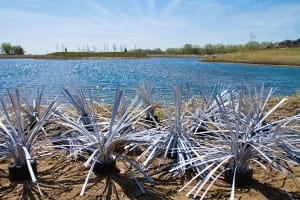
At Fishiding.com we specialize in turning reclaimed PVC into long term products for fish habitat, nutrient removal and producing fish food. The amazing factor in this process is as Green as it gets, with no additional manufacturing or carbon footprint associated with our processes.
Our material comes to us through a network of suppliers, environmentally aware of the desire to keep this material out of landfills and put to good use. In this growing world, we as stewards of nature, must continue to find practical ways to re-use these post consumer products. Protection for aquatic life and growing it’s food, simultaneously, year round. Read below to see how it works, by the leaders in this technology to see if you need: Floating Islands International,Inc. to give you a hand with your water quality questions and needs.
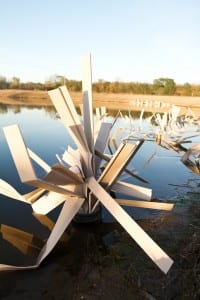
 Trading Nutrients for Fish by Bruce Kania (courtesy of Pond Boss magazine www.pondboss.com)
Trading Nutrients for Fish by Bruce Kania (courtesy of Pond Boss magazine www.pondboss.com)
Fish productivity is enhanced by surface area. When biofilms accumulate on substrate, excess nutrients in the water are used up as the biofilm grows. This in turn feeds the food chain, and leads to bigger and more numerous fish. Catching these fish represents a great way to remove phosphorus permanently from water. Please scroll to page 10 to view the article. Pond Boss magazine is dedicated to managing private waters for fish productivity
Fishiding.com offers products for many different applications in a vast array of sizes. Pieces ranging from 1/4″ wide up to full panels reaching 10″-12″ in width and as long as 12 feet. Many different shapes and textures of substrates for fish habitat as well as unlimited varieties of installation options for hatchery and aquaculture use. It all comes down to providing the correct amount and enough of surface area to handle the load of each individual waterway or volume of bio film needed. See the dozens of unique artificial fish habitat models, fish attractors and fish cover used at fishiding.com, the leader in proven science based, fish protection.
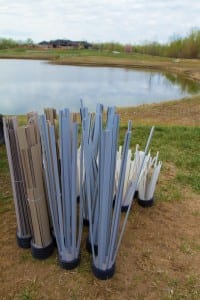
By utilizing post consumer materials, the cost of these unique substrates runs far less than other manufactured products available. When sold in bulk shipments loose, these strands or limbs of textured PVC can cost pennies per square foot of surface area. Strands with or without holes are available to hang or tie groups of substrate sizes together. Self contained and weighted, optional units come ready to bend to shape and toss in water, running slightly higher in price. Available pieces from stiff and rigid “sticks” to soft flexible strands in many colors, lengths and varieties.
Contact David to discuss your needs and receive a custom quote for your project. Shipped worldwide this new understanding of feeding your fish, creating habitat and purifying the water, is gaining much deserved attention.
Stewardship starts with you, for future generations.
David@fishiding.com 815-693-0894
